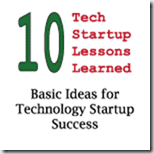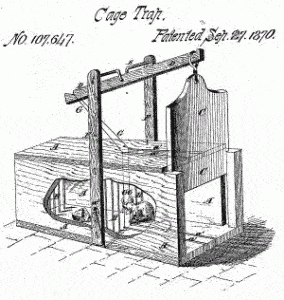 About the Series “10 Tech Startup Lessons Learned”
About the Series “10 Tech Startup Lessons Learned”PADT is a company focused on helping companies bring their physical products to market. As “We Make Innovation Work” for our customers, we learn a lot about what does and does not work in technology startup companies. In addition, we were once a startup ourselves and we now participate in Angel investing. All of this has taught us a lot of valuable lessons.
In this series, we will share some of those lessons learned and explore the basic concepts and ideas that will help startups overcome the odds and become successful. This posting is the second installment of our series. The previous postings were:
- “If You Build It, They Will Not Come”
- “Stay Focused, Be Flexible, Set and Use Goals.”
- “Be Honest and Open about your Strengths and Weaknesses”
- “Believe in Your Idea, but don’t be a True Believer”
We hope that you find it useful and we look forward to sharing our thoughts on this topic with you.
It has been some time since we have added to this series, mostly because we have been busy working with companies both large and small helping to make their innovation work. Its good to be busy. We have also become further involved with several new startups by providing services, mentoring, and angel investing. All of those experiences reinforced an important lesson we have learned through the years: you must have an honest and deep understand of the need in the marketplace, and your focus must be on finding the best possible solution for that need.
Need: What it is, How Much, and How Many
A technology startup is created as a business that uses some sort of technology to solve some sort of need in the market. The need may already be met by existing solutions, it may be unmet, or it may even be a need that no one knows they have. So first, find a need. That is where you start. Define the “Why” for your technology. Then make sure that those who want that need met are willing to pay more for meeting that need than it costs you to provide the solution – profit.
People want coffee. They will pay around $4.35 for coffee. It costs you $0.50 to make and serve a cup– profit. Switch out coffee with any other need and the equation is the same.
It is also a good idea for the need to be one that is large enough that the risk of doing the startup is counterbalanced by the possible return. The old higher risk requires higher potential rewards equation. Taking our food example a bit too far, there are people who want Donkey Milk Cheese. They will pay over $600/pound for it. But if there are only a few hundred of them, you will have a hard time getting investors or employees to invest a lot of money or time in your endeavor. Good enough for a family farm that just needs to make a little bit of money, but not good enough for a technology startup – low or negative profit.
This stuff is startup fundamentals. Identify the market from a business standpoint and really understand it as a market: how strong is the demand (impacts price) and how big is it.
Avoid Overdoing the Need Part
Most companies start by identifying a credible and real need, then they veer off the road and start obsessing about why that need is important. Going on and on about how bad the current solutions are, how it is ignored by others, how others just do not understand it, or that is is the next “big thing.” These things matter, but only in terms of how they contribute to how much people will pay for a solution and how many of them there are.
It is not uncommon for us to listen to a pitch and have the CEO of a startup spend over half of their time talking about the need in the market. Going on and on why the need is significant or important. This should be a small part of a pitch, simply presented to gain some interest and establish the size and desire of the market.
Meet the Need: Develop a Complete Solution that Works and Makes Money

This is where your focus should be. Even if you have not solved the technical problems, you should be planning out what resources and how much money you will need to solve them. If you are looking for funding, investors are going to want to know less about the nuts and bolts of the technology and more about how much it costs to get the technology working, and how much it will cost to produce or maintain the technology you will be selling.
The need to come up with a working solution is so fundamental some may ask why this is even listed in a “Lessons Learned” list. It is obvious. But our experience is that a large number of startup companies take the solution on faith. It is not uncommon for us to be hired by a startup, especially in the clean-tech sector, who wants us to help them evaluate or improve their technology. When we look at the technology we often find that it is not unique, not as good as they think it is, or simply does not work. And this is after the company has funding, employees and interest from customers.
A complete solution also includes a manufacturing or distribution plan. For software, this has become somewhat trivial, but for hardware solutions, it is often overlooked. You need to know as early as possible if you can make your solution, how long it will take to make, and what it will cost to make it.
A Solution Looking for A Problem is a Bad Thing
 When you talk about a market need and a solution, you always need to ask yourself if a startup has a solution, but is looking for a problem to solve. With the rising trendiness of the whole “pivot” thing, many people downplay this more than they should. If the market is wrong, pivot. That is an expensive and painful process.
When you talk about a market need and a solution, you always need to ask yourself if a startup has a solution, but is looking for a problem to solve. With the rising trendiness of the whole “pivot” thing, many people downplay this more than they should. If the market is wrong, pivot. That is an expensive and painful process.
We often see brilliant technical solutions that have a significant “wow” factor associated with them. They are often well-executed and examples of how to do technology right. But they do not have a market or a market has not been identified. This often results from an unrealistic assessment of the need upfront. If you develop a Donkey Milk Cheese that is truly a work of art, your business will fail because you now need to create a market for Donkey Milk Cheese as a cheese, or find a new problem that can be solved with Donkey Milk Cheese. Perhaps it is a good foot balm?
It’s a Business
People have problems with understanding their market and focusing on their solution when they forget that what they are doing is a business. A tech startup is not a club, a social experiment, or a family adventure. It can look like all of those things, but it is a business. And not just any business. It has significant financial and technical challenges and the expectation for it is rapid and significant growth.
Without the identification and understanding of a clear market need, and a team that is focused on providing a technical solution that makes business sense, a startup will surely fail and may not even be able to attract funding.


















